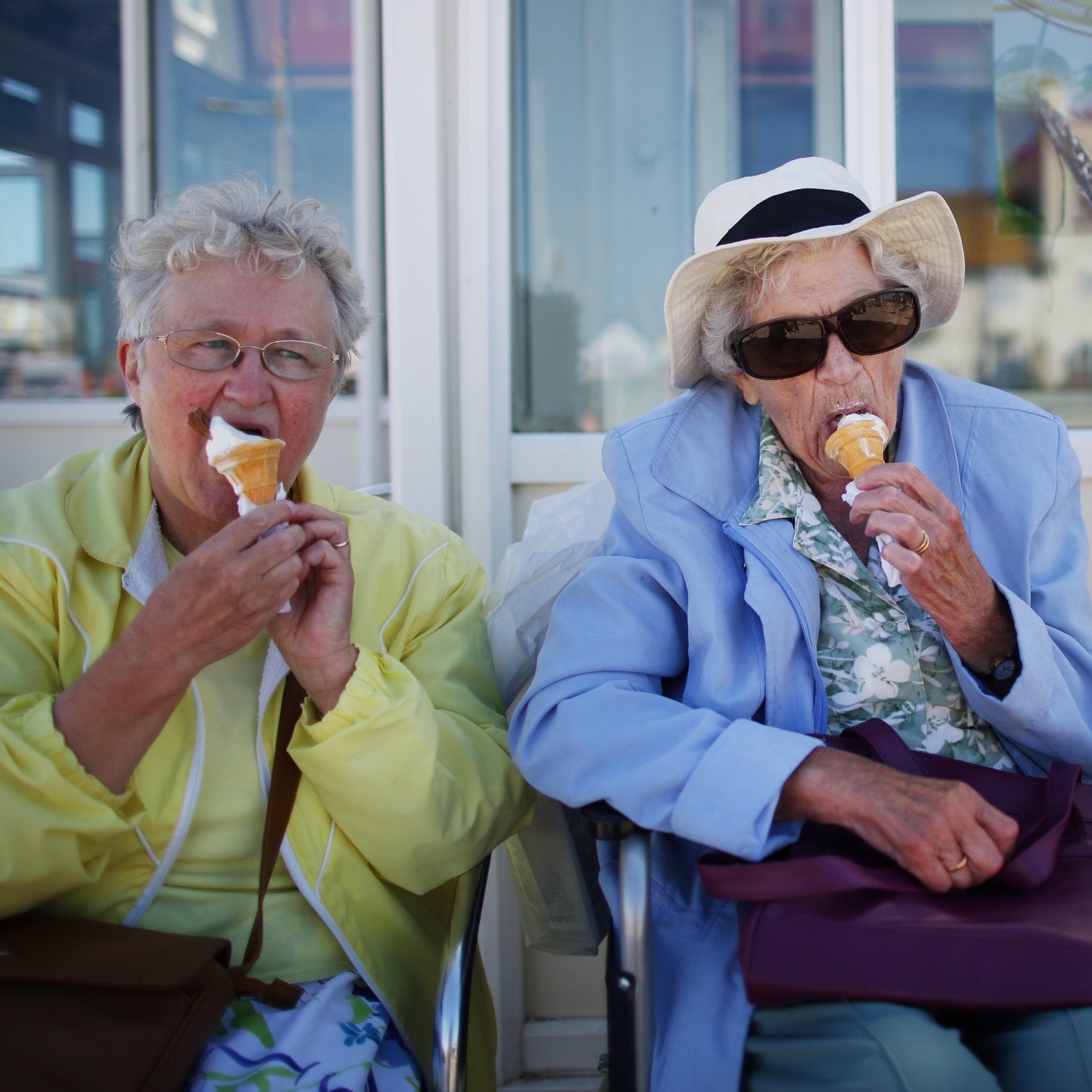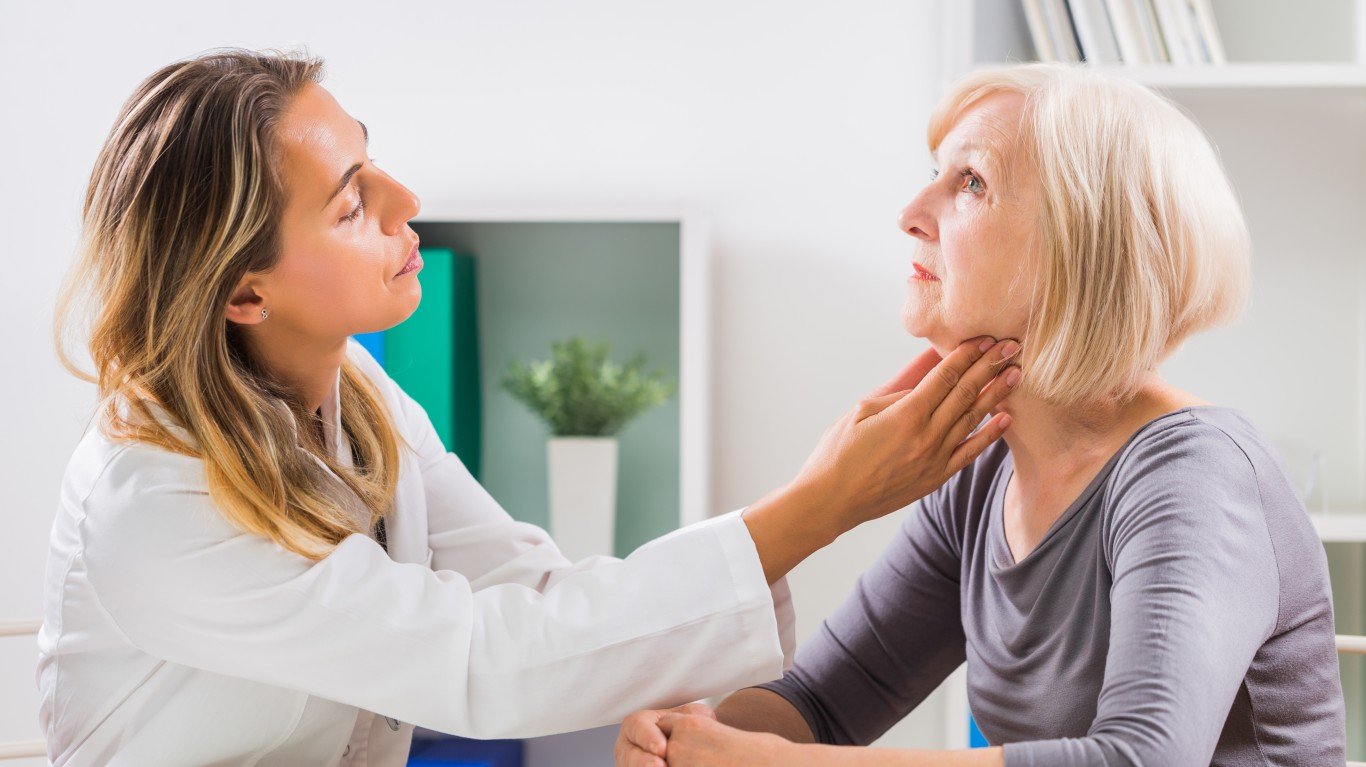

The U.S. health care system faced new levels of scrutiny in the past year amid the COVID-19 pandemic. Some hospitals were dangerously close to exceeding their capacity as COVID-19 patients flooded emergency rooms and ICU wards.
Even before the pandemic, some states were much better equipped to handle both everyday health needs — and the pandemic — than others. There are many states in which residents are much more likely to lack access to care or insurance to help pay for it and have to contend with underfunded medical hospitals.
To identify the states with the worst health care systems, 24/7 Tempo constructed an index comprising six health measures for each state: the share of residents without health insurance, state per capita expenditures on health care and on hospitals, and the ratios of dentists, doctors, and mental health providers per 100,000 people.
Of the 25 states with the worst health care systems, 14 are located in the South. This means that just two Southern states’ health care systems rank outside the bottom half. Conversely, none of the nine Northeastern states ranks in the bottom half of state health care systems. The Midwest has seven states among the worst, and the West has four states.
Much of the quality of a state’s health care system relies on money — both the funding that hospitals and other medical institutions receive and the ability of residents to afford basic care. Of the 25 states with the worst health care systems, just two have a higher median household income than the U.S. median of $65,712. These are America’s richest and poorest states.
Click here to see 25 states with the worst health care systems
To identify the states with the worst health care systems, 24/7 Tempo constructed an index comprising six health measures for each state: the share of residents without health insurance, state health care and hospital expenditures per capita, and the number of dentists, doctors, and mental health providers per 100,000 people. Each of these measures was weighted equally in the index.
Population estimates and the share of residents without health insurance came from the U.S. Census Bureau’s 2019 American Community Survey. The percentage of adults who report fair or poor health came from the 2021 County Health Rankings & Roadmaps, a Robert Wood Johnson Foundation and the University of Wisconsin Population Health Institute joint program, and is based on data from 2018.
State health and hospital expenditures were obtained from the U.S. Census Bureau’s 2019 State and Local Finance data.
Data on hospital beds per 1,000 people was gathered from Becker’s Hospital Review rankings published in March 2020 — the magazine’s ranking is based on analysis of data from the American Hospital Association’s annual survey from 1999 to 2018. Single payer and family employee premium contributions by state were obtained from the Commonwealth Fund, December 2018.

25. Wyoming
> Uninsured rate: 12.3% — 6th highest
> Health care spending in 2019: $513 per capita — 2nd highest
> Adults in poor or fair health: 15.3% — 17th lowest
> Hospital beds: 3.5 per 1,000 people — 6th most
> Employee premium contribution, single coverage: $96 a month — 7th lowest
The health care system in Wyoming ranks worse than half of all other states in the country. This is due in large part to the fact that 12.3% of residents are not insured — the sixth highest percentage among states and well above the national uninsured rate of 9.2%. Uninsured Americans tend to have worse health outcomes as they often skip needed medical care because the costs can be too high without coverage.
Wyoming residents may also struggle to receive needed medical care due to a lack of doctors. There are just 68.2 physicians in the state per 100,000 residents, well below the concentration nationwide of 75.8 doctors per 100,000 residents.
[in-text-ad]
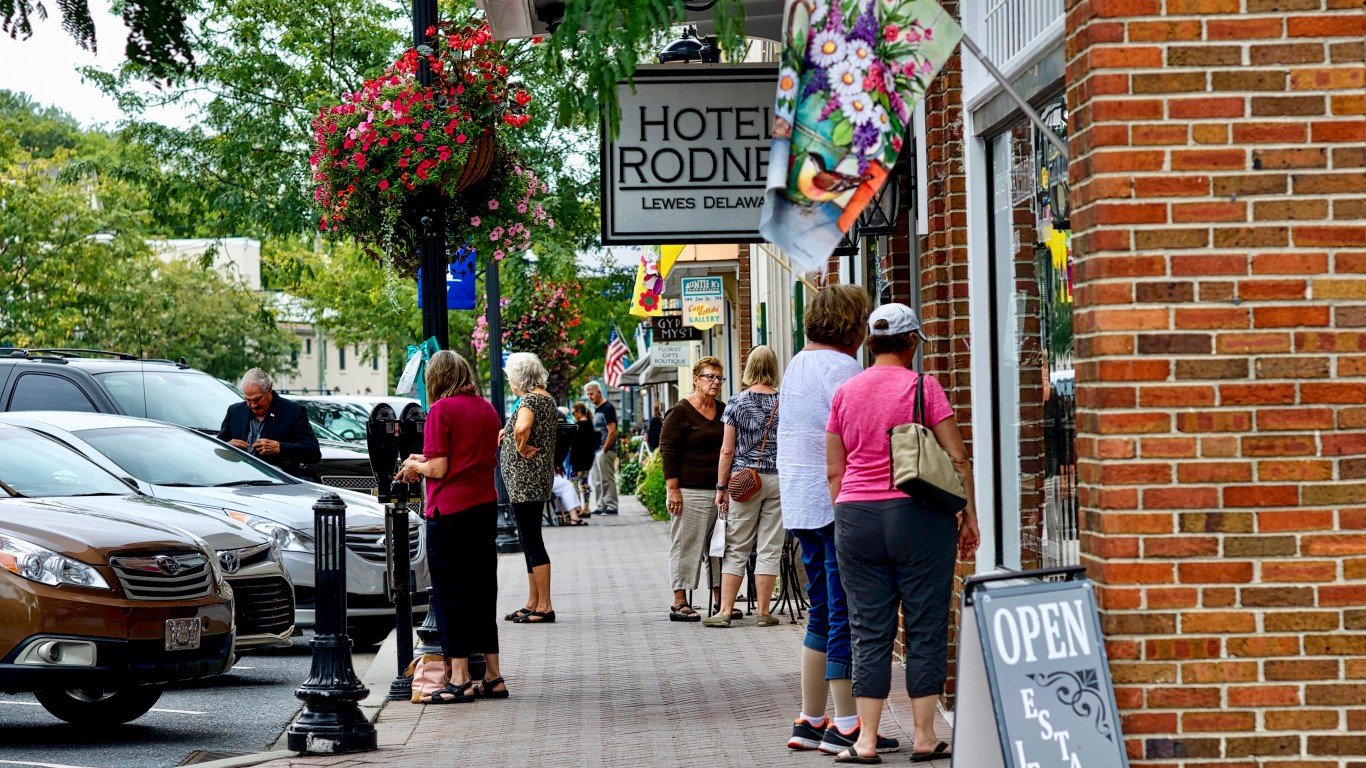
24. Delaware
> Uninsured rate: 6.6% — 15th lowest
> Health care spending in 2019: $480 per capita — 4th highest
> Adults in poor or fair health: 16.3% — 23rd lowest
> Hospital beds: 2.2 per 1,000 people — 20th fewest
> Employee premium contribution, single coverage: $128 a month — 11th highest
Though Delaware’s health care system ranks worse than that of 26 other states, it has several positive aspects as well. For example, a relatively low share of its population is uninsured, at 6.6%, and its residents are among the most likely to have received preventive medical care like flu shots and mammograms.
However, the state’s medical care infrastructure has some gaps. Hospital funding in Delaware is among the lowest in the nation, at just $82 per capita. This is less than a third of the average per capita hospital spending nationwide of $294. Delaware also has fewer hospital beds per capita than most other states, at 2.2 beds per 1,000 residents.
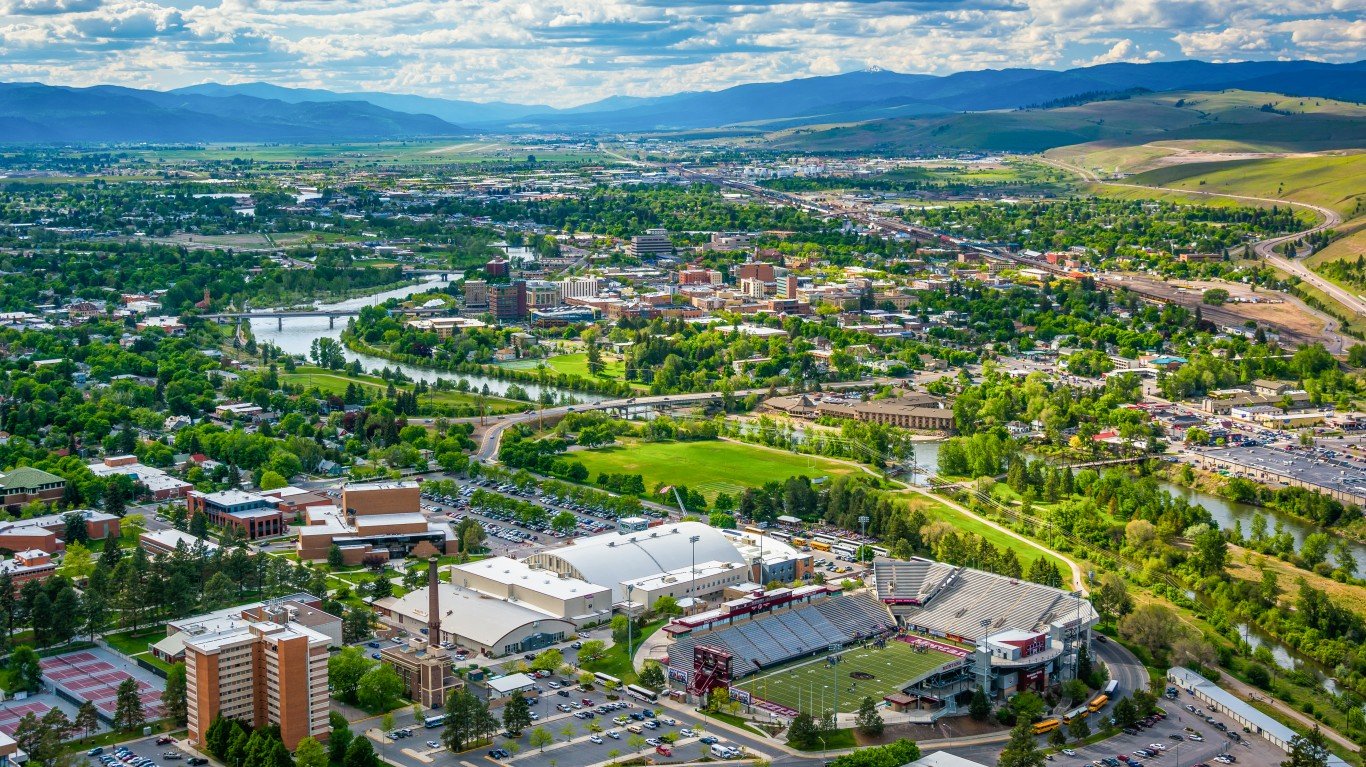
23. Montana
> Uninsured rate: 8.3% — 24th highest
> Health care spending in 2019: $167 per capita — 25th lowest
> Adults in poor or fair health: 14.1% — 11th lowest
> Hospital beds: 3.3 per 1,000 people — 7th most
> Employee premium contribution, single coverage: $94 a month — 6th lowest
Though Montana’s uninsured rate is slightly lower than the national rate, and the ratio of certain health professionals relative to the population is slightly higher than the national figures, the state ranks among those with the worst health care system because of relatively low spending on hospitals and health care. The state spends $61 on hospitals per resident, which is a fraction of the U.S. average of $294 per person. Montana spends about $167 on health care per person, also less than the national average of $205 per person.
About 23.3% of adults in Montana report having unmet mental health needs, the 15th highest share in the country.

22. Missouri
> Uninsured rate: 10.0% — 15th highest
> Health care spending in 2019: $332 per capita — 8th highest
> Adults in poor or fair health: 19.5% — 11th highest
> Hospital beds: 3.1 per 1,000 people — 12th most
> Employee premium contribution, single coverage: $110 a month — 15th lowest
Missouri is on the list of states with the worst health care system in the U.S. for several reasons. One is the higher uninsured rate than the national average. An estimated 10.0% of adult residents don’t have health insurance, the 15th highest share in the country. Another reason is the relatively limited access to health professionals compared to most other states. There are 70.3 primary care doctors per 100,000 residents in the state, compared to 75.8 per 100,000 across the U.S. Missouri also has lower concentrations of dentists and mental health providers per 100,000 residents than most states.
Missouri has one of the highest rates of people reporting poor or fair health, at 19.5% compared to 16.5% in the U.S. as a whole. The state also has one of the highest premature mortality rates at 404 residents dying before the age of 75 per 100,000 people. The national premature mortality rate is below 340 per 100,000.
[in-text-ad-2]

21. Nebraska
> Uninsured rate: 8.3% — 23rd highest
> Health care spending in 2019: $151 per capita — 21st lowest
> Adults in poor or fair health: 13.8% — 10th lowest
> Hospital beds: 3.6 per 1,000 people — 5th most
> Employee premium contribution, single coverage: $113 a month — 18th lowest
Though Nebraska’s uninsured rate is lower than the national rate and the concentrations of certain health professionals relative to the population is slightly higher than the national figures, the state ranks among those with the worst health care system because of relatively low spending on hospitals and health care. The state spends $102 on hospitals per resident, which is about half the U.S. average of $294 per person. Nebraska spends about $151 on health care per person, significantly less than the national rate of $205 per person.
20. Illinois
> Uninsured rate: 7.4% — 21st lowest
> Health care spending in 2019: $97 per capita — 6th lowest
> Adults in poor or fair health: 15.9% — 21st lowest
> Hospital beds: 2.5 per 1,000 people — 22nd most
> Employee premium contribution, single coverage: $115 a month — 24th lowest
Illinois’ health care system ranks among the worst in the U.S. largely due to the state’s relatively low spending on health care and hospitals. The state spends $97 per person on health care, the sixth lowest amount per person in the U.S., and $68 per resident on hospitals, the 13th lowest. Both are well below the respective national figures of $205 and $294.
Illinois residents may also have a harder time accessing mental health specialists than people in other states. There are 245.3 mental health providers per 100,000 residents in Illinois, compared to 261.2 per 100,000 in the U.S. as a whole.
[in-text-ad]

19. Kentucky
> Uninsured rate: 6.4% — 14th lowest
> Health care spending in 2019: $98 per capita — 7th lowest
> Adults in poor or fair health: 21.8% — 4th highest
> Hospital beds: 3.2 per 1,000 people — 10th most
> Employee premium contribution, single coverage: $121 a month — 18th highest
Kentucky’s health care system ranks worse than most other states, in large part because residents may struggle to find access to medical professionals. The state has fewer doctors, dentists, and mental health providers per capita than is typical nationwide.
Even though overall health care spending per capita in Kentucky is one of the lowest among states, at $98, the state’s hospital spending is one of the highest in the nation, at $452 per capita. Only 10 states have higher per capita hospital spending.

18. North Dakota
> Uninsured rate: 6.9% — 19th lowest
> Health care spending in 2019: $188 per capita — 22nd highest
> Adults in poor or fair health: 13.6% — 8th lowest
> Hospital beds: 4.3 per 1,000 people — 2nd most
> Employee premium contribution, single coverage: $99 a month — 8th lowest
North Dakota ranks among the states with the worst health care system in part due to the state’s low concentration of mental health providers and dentists relative to the population. There are 196.3 mental health providers per 100,000 residents compared to 261.2 per 100,000 across the U.S., and 66.4 dentists per 100,000 residents compared to 71.2 per 100,000 in the country as a whole.
North Dakota is among the states that spends the least on hospitals, at $69 per resident, which is significantly less than the $294 national figure. The state also spends less on health care per resident, at $188, compared to the average health care expenditure per capita of $205 across the U.S.

17. South Carolina
> Uninsured rate: 10.8% — 11th highest
> Health care spending in 2019: $247 per capita — 13th highest
> Adults in poor or fair health: 17.8% — 20th highest
> Hospital beds: 2.4 per 1,000 people — 25th fewest
> Employee premium contribution, single coverage: $112 a month — 17th lowest
South Carolina’s health care system faces more challenges than many states, including high uninsured rate, low concentration of health professionals relative to the population and a high premature death rate. About 10.8% of adults in the state don’t have health insurance, higher than in all but 10 other states. There are also just 183.0 mental health providers per 100,000 residents, the eighth lowest ratio in the nation and well below the national concentration of 261.2 mental health providers per 100,000 residents.
South Carolina has the ninth highest premature mortality rate in the country, at 410.6 deaths before age 75 per 100,000 residents. Nationwide, the premature death rate is less than 340 per 100,000.
[in-text-ad-2]

16. North Carolina
> Uninsured rate: 11.3% — 10th highest
> Health care spending in 2019: $164 per capita — 23rd lowest
> Adults in poor or fair health: 18.0% — 19th highest
> Hospital beds: 2.1 per 1,000 people — 18th fewest
> Employee premium contribution, single coverage: $116 a month — 23rd highest
North Carolina’s health care system ranks worse than most other states, in large part because residents may struggle to find access to medical professionals and because of the state’s relatively low spending on health care and hospitals. The state has fewer doctors, dentists, and mental health providers per capita than is typical nationwide and spends less on health care and hospital per capita than the average across U.S. states.
The state has the 10th highest share of adults without health insurance, at 11.3% compared to the nationwide share of 9.2%. About 18.0% of adults report being in poor or fair health, higher than the 16.5% share across the country as a whole.

15. West Virginia
> Uninsured rate: 6.7% — 18th lowest
> Health care spending in 2019: $160 per capita — 22nd lowest
> Adults in poor or fair health: 23.6% — the highest
> Hospital beds: 3.8 per 1,000 people — 4th most
> Employee premium contribution, single coverage: $113 a month — 21st lowest
West Virginia’s health care system faces more challenges than virtually any other — 23.6% of adults in the state reported feeling in fair or poor health, higher than in all other states. West Virginians are also more likely to lack access to health care. There are just 137.8 doctors per 100,000 residents, the third lowest ratio in the nation, and well below the national concentration of 261.2 doctors per 100,000 residents.
West Virginia has by far the highest premature mortality rate in the country, at 504.8 deaths before age 75 per 100,000 residents. Nationwide, the premature death rate is less than 340 per 100,000 residents. The state’s high premature death rate is due in part to the opioid epidemic. West Virginia has the highest rate of fatal overdoses among states, and the rate has been increasing during the COVID-19 pandemic.
[in-text-ad]

14. Oklahoma
> Uninsured rate: 14.3% — 2nd highest
> Health care spending in 2019: $223 per capita — 18th highest
> Adults in poor or fair health: 20.9% — 8th highest
> Hospital beds: 2.8 per 1,000 people — 17th most
> Employee premium contribution, single coverage: $115 a month — 25th lowest
Oklahoma’s health care system faces more challenges than most other states â 20.9% of adults in the state reported feeling in fair or poor health, higher than in all but seven other states. Oklahomans are also more likely to lack health insurance and access to health care. The uninsured rate in the state is 14.3%, the second highest in the U.S. There are also just 60.9 doctors per 100,000 residents, the fifth lowest ratio in the nation and well below the national concentration of 75.8 doctors per 100,000 residents.
Oklahoma has the sixth highest premature mortality rate in the country, at 456.6 deaths before age 75 per 100,000 residents. Nationwide, the premature death rate is less than 340 per 100,000.

13. South Dakota
> Uninsured rate: 10.2% — 13th highest
> Health care spending in 2019: $178 per capita — 24th highest
> Adults in poor or fair health: 13.4% — 5th lowest
> Hospital beds: 4.8 per 1,000 people — the most
> Employee premium contribution, single coverage: $120 a month — 19th highest
South Dakota is one of just 14 states in which more than one in 10 residents are uninsured. People without insurance are more likely to skip needed medical care because of cost, potentially leading to more severe health issues later on.
South Dakota struggled with COVID-19 more than almost any other state. It reported the third highest COVID-19 case rate among states, at 13,903 cases per 100,000 residents. It also had one of the 10 highest death rates, at 223 COVID-19-related fatalities per 100,000.
12. Louisiana
> Uninsured rate: 8.9% — 21st highest
> Health care spending in 2019: $101 per capita — 8th lowest
> Adults in poor or fair health: 21.4% — 5th highest
> Hospital beds: 3.3 per 1,000 people — 7th most
> Employee premium contribution, single coverage: $122 a month — 15th highest
Despite a lower than average uninsured rate, Louisiana ranks among the states with the worst health care system in part due to relatively low state spending on health care as well as hospitals. The state spends $101 per capita on health care and just $76 per resident on hospitals. Both amounts are significantly lower than their respective nationwide figures of $205 and $294.
Louisiana also has a lower concentration of dentists and primary care doctors relative to the population. It also has a high share of adults reporting being in poor or fair health as well as relatively high infant and child mortality. About 21.4% adults report poor or fair health, the fifth highest share in the U.S. The infant mortality rate is 7.9 per 1,000 births, and the child mortality rate is 70.0 per 100,000 children, the third and second highest rates in the country.
[in-text-ad-2]
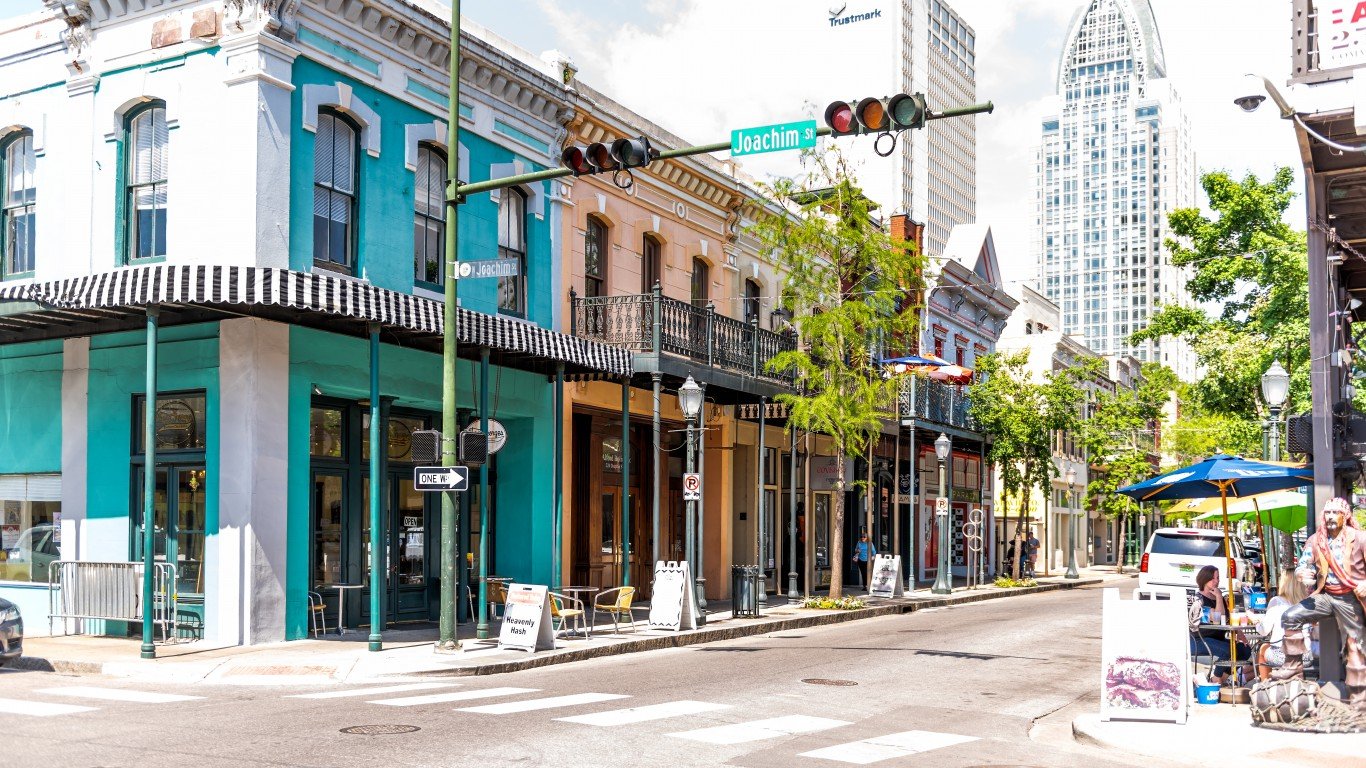
11. Alabama
> Uninsured rate: 9.7% — 17th highest
> Health care spending in 2019: $117 per capita — 17th lowest
> Adults in poor or fair health: 21.4% — 6th highest
> Hospital beds: 3.1 per 1,000 people — 12th most
> Employee premium contribution, single coverage: $133 a month — 8th highest
Alabama ranks among the states with the worst health care system in part due to the state’s low concentration of health professionals relative to the population. There are 108.3 mental health providers per 100,000 residents, the lowest ratio in the U.S., and 65.2 primary care physicians per 100,000 residents, the seventh lowest ratio. About 21.4% of adults report being in poor or fair health, the sixth highest share in the country.
Alabama has the third highest premature mortality rate in the country, at 472 deaths before the age of 75 per 100,000 residents. Nationwide, the premature death rate is less than 340 per 100,000 people. The state’s high premature death rate is due in part to the opioid epidemic. The state had more opioid prescriptions than residents in 2015, according to the CDC.

10. Arkansas
> Uninsured rate: 9.1% — 20th highest
> Health care spending in 2019: $58 per capita — the lowest
> Adults in poor or fair health: 23.3% — 2nd highest
> Hospital beds: 3.2 per 1,000 people — 10th most
> Employee premium contribution, single coverage: $104 a month — 10th lowest
Arkansas’ health care system ranks as the 10th worst in the U.S. largely due to the state’s relatively low spending on health care as well as fewer than average numbers of health professionals per capita. Though the state spends a relatively high amount of money per capita on hospitals, Arkansas only spends $58 per person on health care, the lowest per capita figure in the U.S. and compared to the national average of $205.
Arkansas residents may also have a harder time seeing health specialists than people in other states. There are 66.4 primary physicians per 100,000 residents in the state, compared to 75.8 per 100,000 in the U.S. as a whole. The state ranks the lowest in the number of dentists per 100,000 residents, at 47.6 per 100,000 residents in the state compared to 71.2 per 100,000 people nationwide. The child mortality and infant mortality rates in the state are both the fourth highest in the U.S. The share of adults reporting being in poor or fair health, at 23.3%, is the second highest in the country as a whole.
[in-text-ad]

9. Florida
> Uninsured rate: 13.2% — 4th highest
> Health care spending in 2019: $225 per capita — 16th highest
> Adults in poor or fair health: 19.5% — 10th highest
> Hospital beds: 2.6 per 1,000 people — 21st most
> Employee premium contribution, single coverage: $120 a month — 19th highest
Florida ranks among the states with the worst health care system in part due to the state’s high uninsured rate, relatively low spending on hospitals, and low concentration of mental health providers relative to the population. There are 169.0 mental health providers per 100,000 residents, the ninth lowest ratio in the U.S. About 19.5% of adults report being in poor or fair health, the 10th highest share in the country.
The state’s preventable hospitalizations rate of 4,684 per 100,000 people, infant mortality rate of 6.1 per 1,000 births, and premature death rate at 336.7 deaths before the age of 75 per 100,000 residents are all above the respective nationwide figures.

8. Idaho
> Uninsured rate: 10.8% — 12th highest
> Health care spending in 2019: $104 per capita — 10th lowest
> Adults in poor or fair health: 15.1% — 15th lowest
> Hospital beds: 1.9 per 1,000 people — 10th fewest
> Employee premium contribution, single coverage: $73 a month — 2nd lowest
Idaho ranks as one of the states with the worst health care system largely because residents may have more difficulty getting medical care than those in most other states. The state has just 1.9 hospital beds per 1,000 people, lower than in all but a handful of other states.
Idaho has fewer doctors, dentists, mental health providers per capita than the majority of states. The state also has the 12th highest percentage of residents who are uninsured, at 10.8%. Nationwide, just 9.2% of Americans are uninsured.

7. Tennessee
> Uninsured rate: 10.1% — 14th highest
> Health care spending in 2019: $111 per capita — 15th lowest
> Adults in poor or fair health: 21.2% — 7th highest
> Hospital beds: 2.9 per 1,000 people — 15th most
> Employee premium contribution, single coverage: $119 a month — 22nd highest
Tennessee’s health care system ranks among the worst in the U.S. largely due to the state’s relatively low spending on health care and hospitals as well as fewer than average numbers of health professionals per capita. The state spends $111 per person on health care and $56 per resident on hospitals, both well below the respective nationwide per capita figures of $205 and $294.
Tennessee residents may also have a harder time accessing certain health specialists than people in other states. There are 157.7 mental health providers per 100,000 residents in the state compared to 261.2 per 100,000 in the U.S. as a whole. The state ranks lower in the number of dentists per 100,000 residents with 55.5 dentists per 100,000 residents in the state compared to 71.2 per 100,000 people nationwide. Just over a fifth of Tennessee adults report being in poor or fair health, the seventh highest share in the country.
[in-text-ad-2]

6. Indiana
> Uninsured rate: 8.7% — 22nd highest
> Health care spending in 2019: $90 per capita — 4th lowest
> Adults in poor or fair health: 18.2% — 17th highest
> Hospital beds: 2.7 per 1,000 people — 19th most
> Employee premium contribution, single coverage: $122 a month — 17th highest
Indiana’s health care system ranks among the worst in the U.S. largely due to the state’s relatively low spending on health care and hospitals as well as fewer than average health professionals per capita. The state spends $90 per person on health care and $21 per resident on hospitals, both well below the respective national figures of $205 and $294.
Indiana residents may also have a harder time accessing certain health specialists than people in other states. There are 66.8 primary physicians per 100,000 residents in Indiana, compared to 75.8 per 100,000 people in the U.S. as a whole. The state ranked lower in the number of mental health providers per 100,000 residents — 168.3 per 100,000 residents in the state compared to 261.2 per 100,000 people nationwide. Just over a quarter of Indiana adults have unmet mental health needs as of February 2020, the seventh highest share in the country.
5. Nevada
> Uninsured rate: 11.4% — 8th highest
> Health care spending in 2019: $93 per capita — 5th lowest
> Adults in poor or fair health: 19.1% — 12th highest
> Hospital beds: 2.1 per 1,000 people — 18th fewest
> Employee premium contribution, single coverage: $105 a month — 11th lowest
Nevada ranks among the states with the worst health care system in part due to low government spending on health care and hospitals as well as one of the highest uninsured rates in the U.S. Though the number of mental health providers and dentists per capita in Nevada are slightly lower than the national figure, the concentration of primary care doctors is significantly lower. There are 58.4 doctors per 100,000 state residents, the third lowest rate in the country, and compared to 75.8 doctors per 100,000 people nationwide.
Nevada’s premature death rate, child mortality rate, and share of adults in poor or fair health are all above the U.S. averages. The share of adults with unmet mental health needs is the third highest, at 28.6%.
[in-text-ad]

4. Mississippi
> Uninsured rate: 13.0% — 5th highest
> Health care spending in 2019: $133 per capita — 19th lowest
> Adults in poor or fair health: 22.1% — 3rd highest
> Hospital beds: 4.0 per 1,000 people — 3rd most
> Employee premium contribution, single coverage: $109 a month — 13th lowest
Mississippi ranks as the state with the fourth worst health care system in the U.S. for several reasons. One is the high uninsured rate — 13.0% of adult residents don’t have health insurance, the fifth highest share in the country. Another reason is the relatively limited access to health professionals compared to most other states. There are just 52.9 primary care doctors per 100,000 residents in the state, fewer than in any other state. Mississippi also has one of the lowest concentrations of dentists and mental health providers per 100,000 residents in the U.S.
Maybe partially as a result, Mississippi has the highest infant mortality rate, the highest child mortality rate, the second highest rate of residents dying before the age of 75 per 100,000 people, and the third highest share of adults reporting poor or fair health.
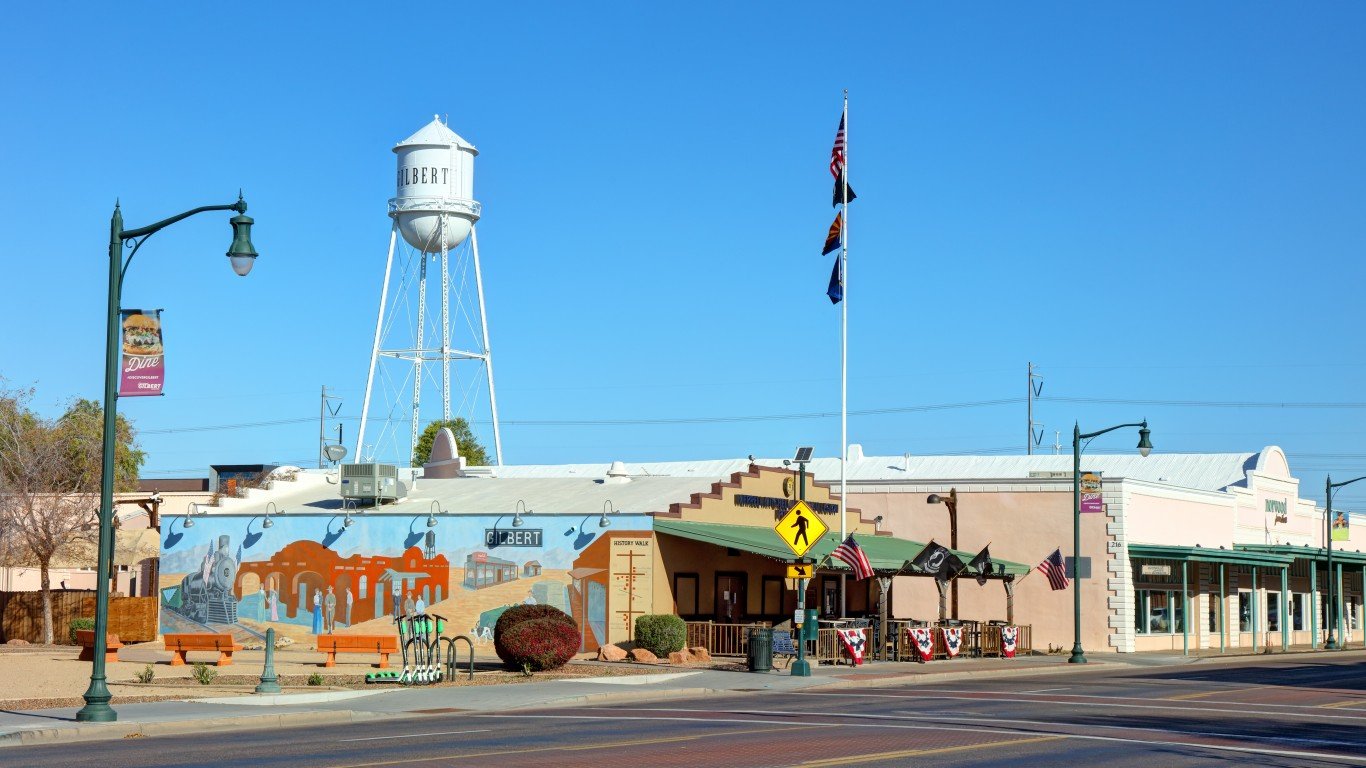
3. Arizona
> Uninsured rate: 11.3% — 9th highest
> Health care spending in 2019: $81 per capita — 3rd lowest
> Adults in poor or fair health: 18.6% — 14th highest
> Hospital beds: 1.9 per 1,000 people — 10th fewest
> Employee premium contribution, single coverage: $127 a month — 12th highest
Arizona’s health care system faces more challenges that most other states â 11.3% of adults in the state don’t have health insurance, the ninth highest share in the U.S. About 9.2% of people under 19 are uninsured as well, the fourth highest share and well above the nationwide figure of 5.7%.
About 18.6% of adult residents report being in fair or poor health, higher than the national share of 16.5%. People in Arizona are also more likely to lack access to health care. There are just 65.7 doctors per 100,000 residents, the ninth lowest concentration in the nation, and well below the national ratio of 75.8 doctors per 100,000 residents.

2. Georgia
> Uninsured rate: 13.4% — 3rd highest
> Health care spending in 2019: $119 per capita — 18th lowest
> Adults in poor or fair health: 18.4% — 15th highest
> Hospital beds: 2.4 per 1,000 people — 25th fewest
> Employee premium contribution, single coverage: $108 a month — 12th lowest
The uninsured rate in Georgia is the third highest in the nation, with 13.4% of adult residents lacking health insurance. In addition, Georgia ranks among the states with the fewest number of health professionals per capita at 52.1 dentists per 100,000 residents (fifth lowest), 145 mental health providers per 100,000 residents (fifth lowest), and 66 primary care doctors per 100,000 residents (10th lowest).
Lack of insurance and limited access to different health specialists may explain Georgia’s high rate of adults reporting poor or fair health at 18.4% compared to the U.S. average of 16.5%. The preventable hospitalizations rate of 4,835 per 100,000 people and the infant mortality rate of 7.3 per 1,000 are among the highest in the country.
[in-text-ad-2]

1. Texas
> Uninsured rate: 18.4% — the highest
> Health care spending in 2019: $109 per capita — 13th lowest
> Adults in poor or fair health: 18.7% — 13th highest
> Hospital beds: 2.3 per 1,000 people — 22nd fewest
> Employee premium contribution, single coverage: $113 a month — 19th lowest
Texas ranks as the state with the worst health care system. This is in large part due to the high rate of residents of all ages lacking health insurance and the limited access to certain types of health care. The uninsured rate, at 18.4%, is double the national figure and higher than that of any other state. The shares of people under 19 and under 6 years old lacking health insurance are also the highest in Texas. The state also has among the fewest mental health providers and primary care doctors per capita.
About 18.7% of adult residents in Texas report being in poor or fair health, the 13th highest share in the U.S. Additionally, Texas has a significantly higher rate of preventable hospitalizations at 4,793 per 100,000 people, the 13th highest in the U.S. This measure reflects how efficiently outpatient services are used as well as the overall quality of health care in a state.
Sponsored: Attention Savvy Investors: Speak to 3 Financial Experts – FREE
Ever wanted an extra set of eyes on an investment you’re considering? Now you can speak with up to 3 financial experts in your area for FREE. By simply
clicking here you can begin to match with financial professionals who can help guide you through the financial decisions you’re making. And the best part? The first conversation with them is free.
Click here to match with up to 3 financial pros who would be excited to help you make financial decisions.
Thank you for reading! Have some feedback for us?
Contact the 24/7 Wall St. editorial team.
 24/7 Wall St.
24/7 Wall St.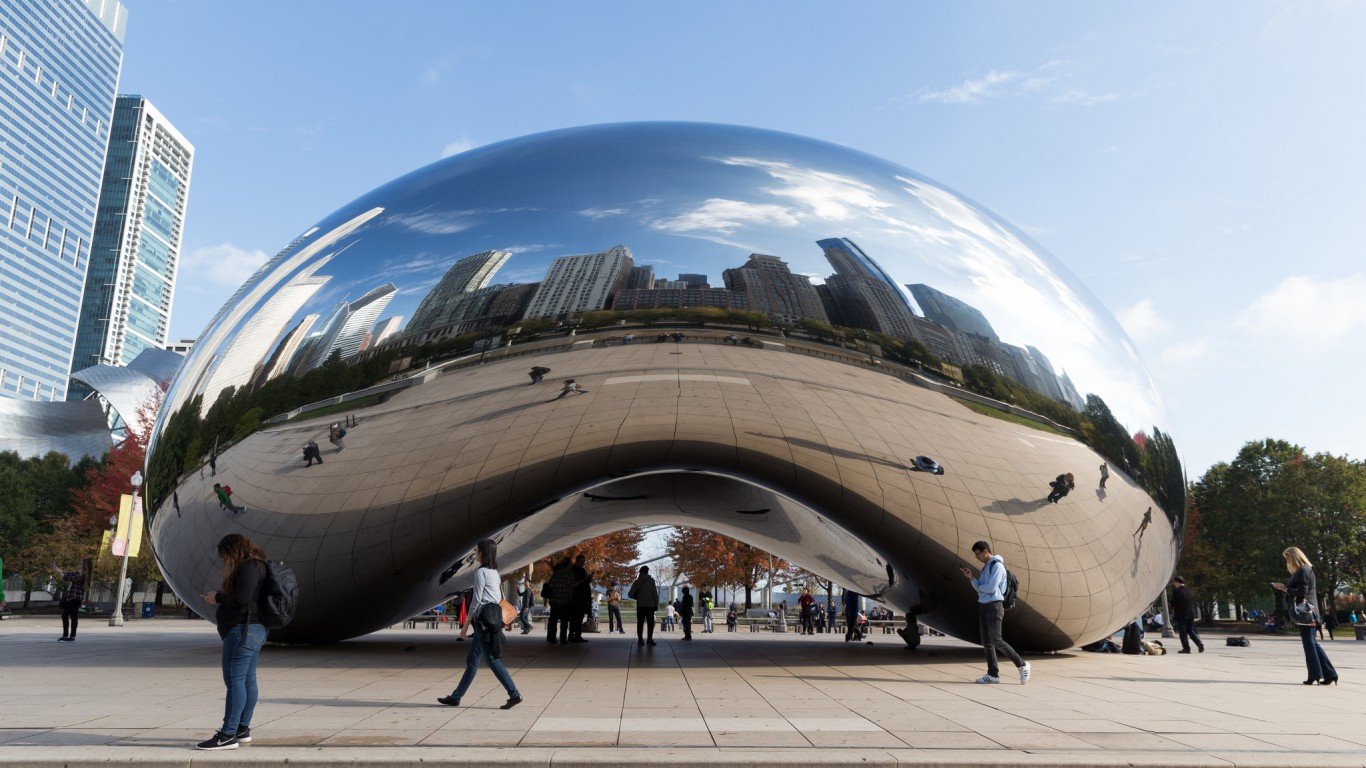

 24/7 Wall St.
24/7 Wall St.


